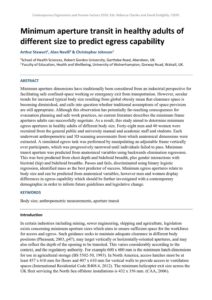| Document | Author Arthur Stewart, Alan Nevill & Christopher Johnson |
| Abstract Minimum aperture dimensions have traditionally been considered from an industrial perspective for facilitating safe confined-space working or emergency exit from transportation. However, secular trends for increased typical body size resulting from global obesity mean that clearance space is becoming diminished, and calls into question whether traditional assumptions of space provision are still appropriate. Although this observation has potentially far-reaching consequences for evacuation planning and safe work practices, no current literature describes the minimum frame apertures adults can successfully negotiate. As a result, this study aimed to determine minimum egress apertures in healthy adults of different body size. Forty-eight men and 40 women were recruited from the general public and university manual and academic staff and students. Each underwent anthropometric and 3D scanning assessments from which anatomical dimensions were extracted. A simulated egress task was performed by manipulating an adjustable frame vertically over participants, which was progressively narrowed until individuals failed to pass. Minimum transit aperture was predicted from anatomical variables using backwards elimination regression. This was best predicted from chest depth and bideltoid breadth, plus gender interactions with bicristal (hip) and bideltoid breadths. Passes and fails, discriminated using binary logistic regression, identified mass as the best predictor of success. Minimum egress apertures relate to body size and can be predicted from anatomical variables, however men and women display differences in egress capability which should be further investigated with a contemporary demographic in order to inform future guidelines and legislative change. |

